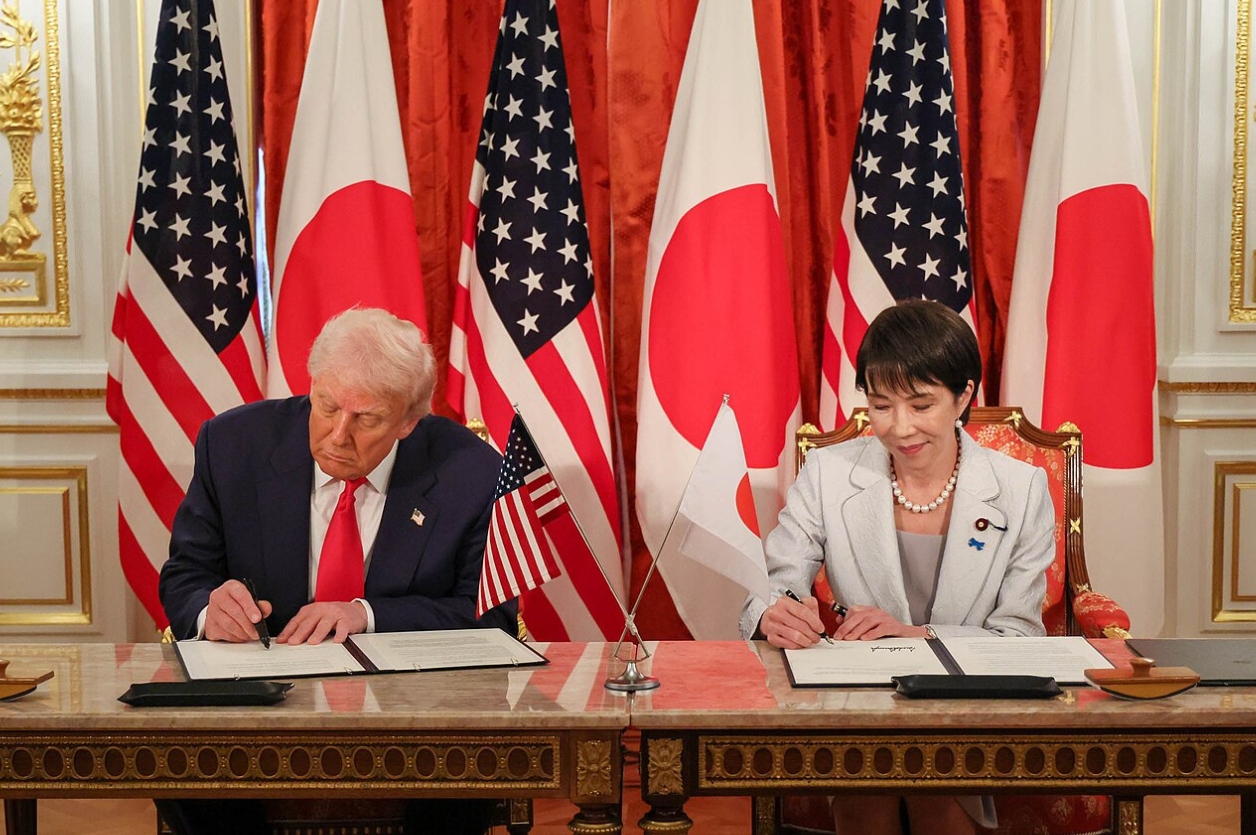US and Japan Deepen Strategic Alliance in Tokyo Summit

Photo credit: Government of Japan
Intelligence Summary
On October 28, 2025, United States President Donald Trump met with Japan’s newly elected Prime Minister Sanae Takaichi in Tokyo for a high-profile summit that produced a series of trade, defense, and critical minerals agreements. The visit marked Takaichi’s first major diplomatic engagement since taking office and was part of Trump’s broader Asia tour, which includes stops in Malaysia and South Korea. The two leaders signed a framework agreement to secure the supply of critical minerals and rare earths through joint mining, processing, and investment initiatives, with the stated goal of reducing dependence on China, which currently processes over 90 percent of global rare earths.
The White House described the deal as a mechanism to strengthen resilience and security in critical minerals supply chains, identifying projects of mutual interest in permanent magnets, batteries, catalysts, and optical materials. Both sides agreed to use coordinated investment and economic policy tools to develop diversified and fair markets for these materials. The agreement also included provisions to streamline permitting processes, address non-market trade practices, and explore complementary stockpiling arrangements with other international partners.
The minerals deal was signed following China’s recent tightening of export controls on rare earths and chip-making equipment, which both Washington and Tokyo likely view as a strategic vulnerability. Trump characterized the agreement as part of a “new golden age” of the alliance between the U.S. and Japan, while Takaichi emphasized her intent to strengthen bilateral ties and accelerate Japan’s defense buildup. The Japanese leader has emphasized her plan to accelerate defense spending to 2 percent of GDP to counter regional threats and preempt potential U.S. demands for greater burden-sharing.
During the visit, Trump and Takaichi also discussed a $550 billion Japanese investment package in the United States, originally agreed earlier in 2025, which includes purchases of U.S. soybeans, natural gas, and pickup trucks, as well as cooperation in shipbuilding. Commerce Secretary Howard Lutnick and Japanese counterpart Ryosei Akazawa were also reported to be discussing the possible implementation of power grid development.
The summit featured symbolic gestures underscoring continuity with the late Prime Minister Shinzo Abe, Takaichi’s mentor and Trump’s former ally. Takaichi presented Trump with Abe’s golf club and other commemorative gifts, while Trump praised her leadership and reaffirmed the alliance’s strength. The two leaders are expected to visit the U.S. naval base in Yokosuka, home to the aircraft carrier USS George Washington, where Trump will address U.S. troops and highlight the alliance’s military dimension.
The Tokyo visit occurs just days before Trump’s scheduled meeting with Chinese President Xi Jinping at the Asia-Pacific Economic Cooperation (APEC) gathering in South Korea, positioning the U.S.–Japan agreements strategically before broader regional negotiations take place. The timing and messaging underscore a coordinated effort to align economic and security policy, likely in response to China’s tightening control over critical supply chains and its growing regional assertiveness.
Why it Matters
The October 2025 U.S.–Japan summit represents a significant commitment from both Trump and Takaichi to prioritize the alliance between their nations.The rare earths and critical minerals agreement is strategically important because it directly targets one of China’s most effective economic levers: its dominance in the processing and export of materials essential for advanced manufacturing, defense systems, and renewable energy technologies. By committing to joint investment, deregulation, and stockpiling, Washington and Tokyo are attempting to build a parallel supply chain architecture that reduces vulnerability to Chinese export restrictions.
The deal also reflects a broader shift in alliance management. Japan’s pledge to accelerate defense spending to 2 percent of GDP signals a willingness to assume greater responsibility for regional security, aligning with U.S. expectations for burden-sharing. This move strengthens deterrence in the region, particularly around contested maritime zones, while also reinforcing Japan’s domestic defense industry. The visit to the Yokosuka naval base highlights the integration of economic and military dimensions in the alliance’s strategic posture.
For the United States, the agreements serve multiple objectives. Economically, they secure access to critical inputs for defense and technology sectors. Politically, they demonstrate progress in alliance diplomacy ahead of Trump’s meeting with Xi Jinping, providing leverage in trade negotiations. Strategically, they reinforce a network of partnerships extending from Southeast Asia to Japan that collectively constrain China’s ability to use economic coercion. The inclusion of commitments to streamline permitting and coordinate investment mechanisms suggests that Washington and Tokyo are institutionalizing their cooperation.
For Japan, the summit was a test of Takaichi’s diplomatic skill and domestic authority. Her ability to secure favorable terms while avoiding new U.S. demands on defense spending or trade concessions strengthens her political position domestically. The symbolic continuity of Shinzo Abe’s legacy also reassures both domestic and international audiences that Japan’s foreign policy remains stable and pro-alliance.
The timing of the summit is also strategically relevant as well, immediately preceding the APEC meeting and Trump’s engagement with Xi. It projects a united front among U.S. allies in Asia and demonstrates that Washington retains the capacity to mobilize economic and security coalitions despite ongoing trade frictions with Beijing. The rare earths deal, in particular, may influence China’s positioning in upcoming negotiations by showing that alternative supply networks are being actively developed.
In the long term, the agreements could reshape the Indo-Pacific’s strategic economy. If implemented effectively, they would diversify global supply chains for critical minerals, reduce exposure to single-country risks, and enhance the resilience of allied defense industries. However, the success of these initiatives will depend on sustained political commitment, regulatory alignment, and the ability to attract private investment. The summit thus marks both a symbolic and practical step toward a more integrated strategic partnership between the U.S. and Japan, with implications extending from energy security to military deterrence and global trade governance.
Key Actors
- United States
- Japan
- China
- Asia-Pacific Economic Cooperation (APEC)

